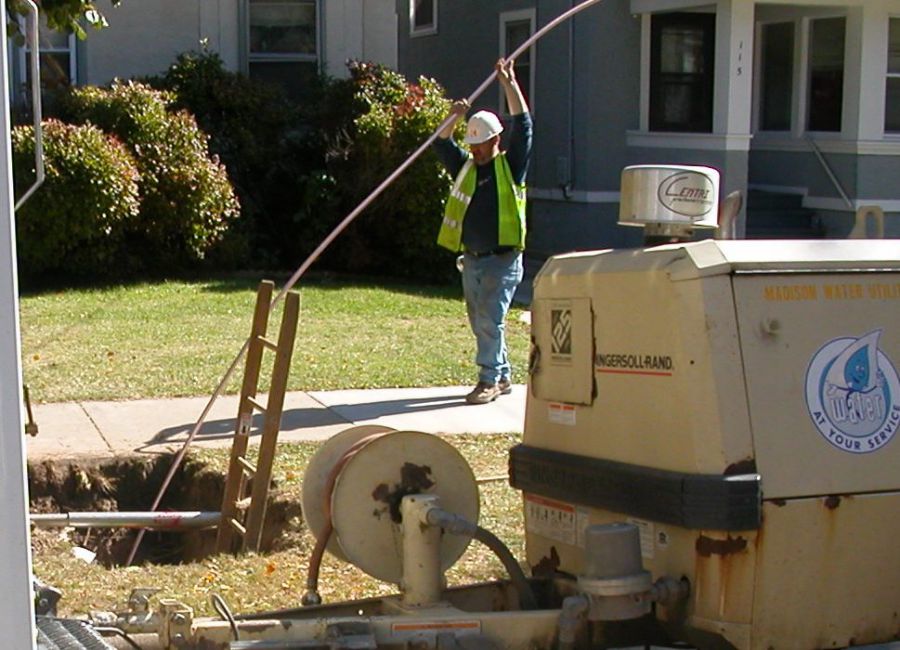Information for utilities on lead service replacement
Madison Water Utility has gotten inquiries from utilities all over the country about our Lead Service Replacement Program. In 2000, Madison was the first major city in the country to adopt a full lead service replacement initiative. Below, you'll find information about how the program was funded, average replacement costs, homeowner reimbursements, and more. If you have any further questions about lead service replacements, please contact water@madisonwater.org.

In 2000, Madison’s Common Council passed an ordinance (Madison General Ordinance 13.18) that requires property owners to replace their side of a water service if it’s lead. The penalty for non-compliance is a fine of $50-$1,000 per day. We did have a handful of property owners who refused to comply with the city’s lead service replacement ordinance. Those cases were turned over to the city attorney’s office. We also discover 1-2 properties a year during main work, street replacements, etc. that have lead services. Customers who discover a lead service can still receive reimbursement for half the cost of replacement up to $1,500 (the reimbursement was raised in 2017 from $1,000). They can also apply for financing through the city to help pay for the remainder of the cost.
For each property where a private-side lead lateral will be replaced, a licensed plumber is required to fill out an Application for Lead Replacement Contract before work begins. When work is completed, the property owner fills out an Application for Reimbursement Form, which is sent to them upon receipt of the contract from their plumber and can then be submitted with a paid receipt.
Prior to our Lead Service Replacement Program, we did not generally keep records of the material used on the property owners’ side of the lateral. But we did often have records noting the material used on our side, so we had a good idea which properties were likely to be impacted by the ordinance. (Madison stopped using lead for water pipes in the late 1920s.) We sent surveys to thousands of property owners which they were required to fill out, sign and return to us stating what material was used for their water service. We held community meetings across the city where we showed people how to locate their service and do a scratch test to check for lead.
In addition, the utility has exhaustively documented the composition of water service lines through staff inspections (meter shop and construction inspectors), and observations by contractors and inspectors during water main replacement projects. Efforts to identify additional lead water service lines continue today albeit with less urgency since, based on the available information, it is assumed that the remaining service lines are not lead.
Here is more information about our program that may be helpful:
-
Our program replaced more than 8,000 lead service pipes, but only about 5,600 of those included the property owner’s side (many people had already replaced their portion of the service in the decades since 1930).
-
The cost of the program was about $15.5 million over 12 years (not including what property owners paid).
-
Wisconsin’s Public Service Commission did not allow us to use rate-payer dollars to fund customer reimbursements, but we were able to use revenue generated by renting space on top of our water towers to cell phone companies for their antennas.
-
While our crews handled the utility-side replacements, private plumbers handled the private side. We often worked closely with plumbing companies, leaving trenches open after replacing our side to lower the cost for homeowners. Plumbers would then follow us down the street replacing the private side immediately after our work was done.
-
During the program, our average reimbursement for half the cost of the private-side lateral was $670. So the entire cost to replace the private-side portion was $1340 on average.
-
The average cost to replace our side during the program was $1997.
-
Between 2000 and 2006, our annual capital budget was about $7-9 million. During those years, we spent about $1-1.5M on utility-side lead service replacements annually. After 2006, the amount we spent on lead service replacements dropped off to less than $100K a year.
-
Properties that had tested high for lead, as well as places like schools and apartment buildings, were prioritized during the program, so their services were replaced right away.
-
80% of replacements were completed between 2000 and 2006. The rest were completed during already planned street and main replacement projects between 2007 and 2012.
-
Before our Lead Service Replacement Program was enacted, our 90th percentile lead result was 16 µg/L. However, it was not uncommon to find results of 40, 50, even greater than 100 µg/L at some homes.
-
We continue to monitor for lead at the customer tap. Each time (twice in 2011 and once in 2014) the 90th percentile level has been around 3 µg/L. Lead testing will occur again in 2020 and then every three years after that.
